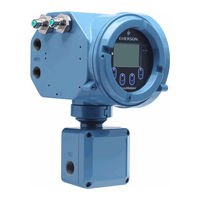Emerson Micro Motion 5700 Manuals
Manuals and User Guides for Emerson Micro Motion 5700. We have 12 Emerson Micro Motion 5700 manuals available for free PDF download: Configuration And Use Manual, Instruction Manual, Installation Manual, Installation Instructions Manual
Emerson Micro Motion 5700 - Ethernet Transmitters Manual
Brand: Emerson
|
Category: Transmitter
|
Size: 1 MB
Table of Contents
Advertisement
Emerson Micro Motion 5700 Configuration And Use Manual (357 pages)
Transmitters with Configurable Outputs
Brand: Emerson
|
Category: Transmitter
|
Size: 6 MB
Table of Contents
Emerson Micro Motion 5700 Configuration And Use Manual (286 pages)
Model 5700 with Ethernet
Brand: Emerson
|
Category: Transmitter
|
Size: 6 MB
Table of Contents
Advertisement
Emerson Micro Motion 5700 Instruction Manual (58 pages)
Transmitters with Configurable Inputs and Outputs
Brand: Emerson
|
Category: Transmitter
|
Size: 5 MB
Table of Contents
Emerson Micro Motion 5700 Installation Manual (56 pages)
With Configurable Outputs, All Installation Types Integral, 4-Wire, and 9-Wire
Brand: Emerson
|
Category: Transmitter
|
Size: 5 MB
Table of Contents
Emerson Micro Motion 5700 Installation Manual (56 pages)
Ethernet Transmitters
Brand: Emerson
|
Category: Transmitter
|
Size: 8 MB
Table of Contents
Emerson Micro Motion 5700 Installation Manual (54 pages)
Ethernet Transmitter
Brand: Emerson
|
Category: Transmitter
|
Size: 14 MB
Table of Contents
Emerson Micro Motion 5700 Installation Manual (46 pages)
Transmitters with Intrinsically Safe Outputs
Brand: Emerson
|
Category: Transmitter
|
Size: 5 MB
Table of Contents
Emerson Micro Motion 5700 Installation Manual (46 pages)
Brand: Emerson
|
Category: Transmitter
|
Size: 6 MB
Table of Contents
Emerson Micro Motion 5700 Installation Manual (44 pages)
Intrinsically Safe Outputs. All Installation Types (Integral, 4-Wire, and 9-Wire)
Brand: Emerson
|
Category: Transmitter
|
Size: 4 MB
Table of Contents
Emerson Micro Motion 5700 Installation Manual (54 pages)
Brand: Emerson
|
Category: Transmitter
|
Size: 4 MB
Table of Contents
Emerson Micro Motion 5700 Installation Instructions Manual (12 pages)
ATEX Zone 2/22 II 3 G or II 3 (2) G/EPL Gc & II 3 D/EPL Dc
Brand: Emerson
|
Category: Transmitter
|
Size: 0 MB
Advertisement
Related Products
- Emerson Rosemount 5081-T
- Emerson 5301HxxxxxxxxxxxxxxZZ Series
- Emerson 5303HxxxxxxxxxxxxxxZZ Series
- Emerson Rosemount 5302
- Emerson Rosemount 5301
- Emerson ROSEMOUNT 5081-A
- Emerson Rosemount Analytical HART 5081-A-HT
- Emerson Rosemount 550PT
- Emerson Rosemount 551
- Emerson Micro Motion Transmitters and Discrete Controllers Series 3000











